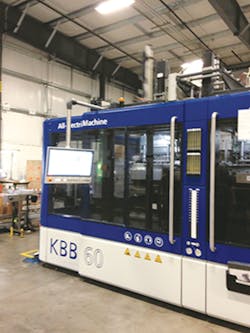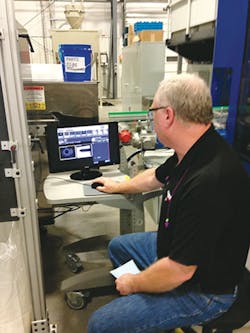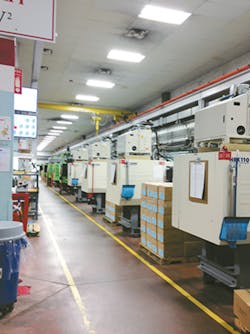Investments keep Currier Plastics out front
Currier Plastics Inc., Auburn, N.Y., is taking its chance on cutting-edge technology and also investing heavily in automation to keep itself ahead of the game in a market where price, delivery and quality are expected but speed to market and design prowess allow a processor to maintain a competitive edge.
The company was started by Raymond Currier in 1982; his son, John Currier, now is leading it. Its recent investments have included major upgrades in blow molding technology. Although it also is a custom injection molder, Currier has been significantly honing its blow molding expertise.
One of its recent installations, a KBB 60 double-station extrusion blow molding (EBM) machine, is a sight to behold. It has a footprint of 360 square feet. This all-electric behemoth produces hotel amenity bottles in an entirely automated process. It is the first installation of the technology from Kautex Maschinenbau GmbH, Bonn, Germany, in the North American market. The company's U.S. operation is Kautex Machines Inc., North Branch, N.J.
Currier began as an injection molder and moved into blow molding in 1997, largely out of a desire to be able to supply blow molded bottles and injection molded caps to its customers.
"We started very small," said President John Currier in a recent interview at Currier's factory. "We bought two used blow molding machines and just kind of built from there. Now our claim to fame is, we think we are one of 25 molders in the United States that do design, injection molding and blow molding, all as one company."
Purchasing equipmentrequires a plan
The key to maintaining the company's position in this market is the selection of machinery and equipment. Every year, officials set a goal of what they will reinvest in equipment purchases.
"We want to spend the money as reinvestment," Currier explained. "And every year it's different. It's been as high as 10 percent of sales in reinvesting in equipment. We also set a budget where we say, 'OK, you guys have this much to spend, spend it wisely.' "
Requiring a matrix
Machinery and equipment purchases are considered carefully, and the company is willing to invest in the latest technology. The KBB 60 is a prime example of that. Company officials visit the K show, the triennial plastics industry show held in Düsseldorf, Germany, to seek out technology.
"For blow molding, the United States is kind of a wasteland," said Currier. "There are just very few machines made in the U.S. We started going over to the K show, and we did a lot of investigations." Officials identify potential suppliers, then they set up a matrix of roughly 15 criteria upon which each supplier is graded.
"We're going to evaluate price; we're going to evaluate lead time; we're going to evaluate mechanical reliability, and support for repairs and maintenance," said Currier, naming just a few of the criteria. Service and support have become critical components for Currier, especially since the company had a negative experience with a former supplier. With the matrix approach, Currier's goal is to remove the bias he believes can occur when choosing suppliers.
"In the end, you still have to say, 'OK, does this make sense to me? Did the manufacturer that I expected come out on top?' We try to do that with every major type of equipment purchase and we're just about to go through that again on blow molding. We have selected Kautex as our EBM supplier. They have done a fantastic job."
The KBB line was introduced at K 2013 by Kautex, featuring compact design, low energy consumption and higher output. Those features were just what Currier wanted in a machine, but it was a leap of faith for John Currier to agree to invest in the machine.
"I don't like buying first-offs of anything," he said. However, Kautex promised not to leave the company's side until Currier had what it wanted.
"It wasn't the perfect machine when it showed up, but it was pretty darn good," said Currier. "Any time we had a problem, they flew people in; they supported us. The service was exceptional. They said, 'We will stand by this machine because it's important to us.' "
On the day of the tour, students from Cayuga Community College, also in Auburn, came to learn about the KBB 60.
Scott Reilly, blow molding department manager at Currier, stood next to it and watched as the HDPE parison was extruded, then the mold clamped around the parison to form the bottle. The bottles are for personal care products like shampoo and conditioner and end up in hotel bathrooms across the country. The machine has a production capacity of 10 million bottles per month.
"People will say that it takes black magic to run an EBM machine," he said. "You've got a piece of plastic, that parison, hanging in mid-air, dangling there, get that mold over it," he clapped his hands for emphasis, "close it, make a perfect bottle."
In consumer packaging, timing is everything and consistency is critical. Kautex engineered the all-electric machine with what it calls a perfectly proportional drive system. Kautex accelerated the feed movement and optimized the motion profiles of all the moving axles so that the number of cycles per hour could be increased.
"It is as consistent as can be," Reilly said of the model from Kautex, which he calls a "gem." The bottles come out, they go into an orienter, and then they are inspected by two cameras.
"Our employees don't have to do anything," he said. "They come here, grab the boxes, and they're done."
Currier's other recent blow molding purchases, announced by officials in March, include two injection stretch blow molding machines from Aoki Technical Laboratory Inc., Sakaki, Japan. The 75-ton machines will allow Currier to work with higher-cavitation molds for wide-mouth PET containers primarily used in the cosmetics industry.
Deciding to do it in-house
Sometimes, Currier creates equipment in-house. Take, for example, end of arm tooling (EOAT). Many of the examples cited by Currier officials are from injection molding projects, but their blow molding operations also are benefitting from automation innovations.
On a recent project for molding a car air freshener vent clip, Currier created the EOAT in-house, said Todd Lindsay, injection molding engineering manager. The part required overmolding and eight parts needed to be placed in the mold simultaneously.
"It still has an operator as of right now," Lindsay said. "But the operator couldn't put all of the parts into the mold at once. So we ended up programming a robot to do it." The operator puts the parts on a table, the robot picks the parts from the table, places them into the mold and verifies that the parts are in the mold.
"If there is a part missing, the robot detects it and is able to stop," he said. For Currier, building the EOAT in-house cut the cost by a quarter. Had the company outsourced the project, the lead time would have been 20 weeks compared to eight weeks.
In blow molding, automation is taking different forms. When producing laundry detergent bottles, for example, Currier now automatically inserts spouts that it molds in the injection molding department. Officials are installing more vision-inspection and product-handling systems. Vision-inspection systems are a focus for the company this year. The KBB 60 has two such systems.
"Believe me, if there are defects, we will know about them immediately," said Reilly.
Operations structured into cells
During the past year, both the blow molding and injection molding operations here underwent a significant change, shifting to work cells. A few employees are assigned to a cell and they are tasked with knowing that cell better than anyone. Multiple machines are assigned to one cell.
"It creates a focus where if you have to investigate the automation in that cell, you have those few individuals in that cell who are there every single day. They know the equipment in and out, they know the vendors," said Reilly. "You almost think of it as your own business. You've got your engineer, and they treat it like their own business. They talk to the customers and get their input so that they can spec out the automation equipment to meet the program requirements."
In addition, it makes it easier for Currier to add equipment to the cell because the engineers who are supervising stations have gained enough expertise to teach their colleagues.
At any given time, multiple training programs are underway at Currier. John Currier explained that because of the company's growth path, it never has lost a position by bringing in automation.
"We've said we're going to continue to grow," he said. "There will always be additional work, and along with that, your purpose is to retrain that person to do something more valuable."
Because of the added automation, employees now are trained to analyze the statistical process control (SPC), where before, they had to manually measure and inspect parts, which is time-consuming.
"Now they can look for trends or shifts in the process and react much quicker," said Reilly. "This makes it easier for us from a processing standpoint, which in turn is better for our customers."
Angie DeRosa, managing editor
Contact:
Currier Plastics Inc., 315-255-1779, www.currierplastics.com




